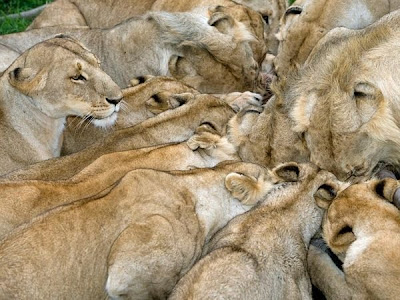Status: Appendix II of CITES, Threatened Species; Asiatic ssp. is CITES appendix I, endangered species.
Scientific Name: Panthera leo (previously Felis leo and Leo leo)
Common Name: Lion (Swahili: Simba Zulu: Ingonyama )
Kingdom: Animalia
Phylum: Chordata (vertebrata)
Class: Mammalia
Order: Carnivora
Family: Felidae
Genus: Panthera
Species: Leo
Common Name: Lion (Swahili: Simba Zulu: Ingonyama )
Kingdom: Animalia
Phylum: Chordata (vertebrata)
Class: Mammalia
Order: Carnivora
Family: Felidae
Genus: Panthera
Species: Leo
Sizes: Male: Avg. Length of body: 6 ft. 4 in. (1.95 meters) Avg. length of tail: 2 ft. 9 in (84 cm)
weight: 325-470 lbs. (148-213 Kg.). Captive lions tend to be bigger:
400-550 lbs (206-250 kg.)
Height at shoulder: 36 in. (90cm.)
Female: Avg. Length of body: 5 ft. 10 in. (1.8 meters) Avg. length of tail: 2 ft. 9 in (84 cm)
weight: 220-360 lbs. (100-164 Kg.).
Height at shoulder: 30 in. (75 cm)
(Lengths include the tail. Height measured at the shoulder.)
Lifespan: 12 years in the wild, 20 years in captivity. Females typically live a few more years in the wild.
weight: 325-470 lbs. (148-213 Kg.). Captive lions tend to be bigger:
400-550 lbs (206-250 kg.)
Height at shoulder: 36 in. (90cm.)
Female: Avg. Length of body: 5 ft. 10 in. (1.8 meters) Avg. length of tail: 2 ft. 9 in (84 cm)
weight: 220-360 lbs. (100-164 Kg.).
Height at shoulder: 30 in. (75 cm)
(Lengths include the tail. Height measured at the shoulder.)
Lifespan: 12 years in the wild, 20 years in captivity. Females typically live a few more years in the wild.
Maximum speed: 35 mph over 50 yds. ( 56 kph. over 46 m.) Biggest Jump: 12 ft. (3.7 m.) vertical, 36 ft. (10.8 m.) horizontal.
Gestation period: 105-115 days.
Body Temperature: 101 deg. F (38.33 deg C)
No. of Teeth: 30 Dental formula: Carnivore I 3/3, C 1/1, P3/2, M 1/1 Some variation has been reported.
Body Temperature: 101 deg. F (38.33 deg C)
No. of Teeth: 30 Dental formula: Carnivore I 3/3, C 1/1, P3/2, M 1/1 Some variation has been reported.
Subspecies: Extinct: Barbary Lion (P.l. leo) - Extinct 1920, but it is suspected more and more that they may exist in captivity in America and Africa.
Cape lion (P.l. melanochaitus) - Extinct 1850 The Cape Lion may also very well be existing in captivity.
Cape lion (P.l. melanochaitus) - Extinct 1850 The Cape Lion may also very well be existing in captivity.
Endangered: Asiatic Lion (P.l. persica) - Gir forest sanctuary of NW India
Threatened: Angola Lion (P.l. bleyenberghi) - Zimbabwe, Angola and Zaire
Masai Lion (P.l. massaicus) - Eastern Africa (Notably Kenya and
Tanzania)
Senegalese Lion (P.l. senegalensis) - Western Africa
Transvaal or South African Lion (P.l. kruegri) - Botswana, Nambia, and South Africa. (White Lions included here.)
Note: Subspeciation in the lion is a subject of considerable debate. Many researchers feel there are only two subspecies: African and Asiatic.
Masai Lion (P.l. massaicus) - Eastern Africa (Notably Kenya and
Tanzania)
Senegalese Lion (P.l. senegalensis) - Western Africa
Transvaal or South African Lion (P.l. kruegri) - Botswana, Nambia, and South Africa. (White Lions included here.)
Note: Subspeciation in the lion is a subject of considerable debate. Many researchers feel there are only two subspecies: African and Asiatic.
Appearance: Lions are the only cat to display sexual dimorphism (difference between the male and female). All lions have a light to medium tan coat consisting of short, stiff hair. Cubs and younger individuals often have light rosette-like spots, especially on the hindlimbs. The area around the whisker beds and under the mouth are often lighter in color or white. The belly is almost always lighter in color than the rest of the coat.
The male has a mane about the neck and shoulders. The extent of the mane varies considerably among individuals, from a scruffy collar to an impressive mantle that may run down the belly to the fronts of the back legs. Mane color can vary between light tan and black. Lions often have several different colors in their mane, and captive lions have been observed to have some red and gold colors. Mane hair is stiff and somewhat wiry; the individual hairs have a pronounced 'crinkle' to them to help them 'puff out'.
In general, the mane gets longer and darker with age. Research has shown that lionesses prefer males with bigger and darker manes. Lions in some areas of Africa can also be maneless. The most famous maneless lions are to be found in the Tsavo area of Kenya.
White lions are observed in some parts of the transvaal in South Africa. The Timbavati area is famous for occasionally producing white lions. The overall coat tends to be light tan. The mane is often snow- white. Contrary to popular belief, white lions have light amber eyes.
Asiatic lions are very similar to African lions. They tend to be a bit smaller. They have thicker coats and often scruffier manes. Asiatic lions usually have a 'belly fold' hanging loosely below their bodies, while this is rare in the African ssp's.
Asiatic lions are very similar to African lions. They tend to be a bit smaller. They have thicker coats and often scruffier manes. Asiatic lions usually have a 'belly fold' hanging loosely below their bodies, while this is rare in the African ssp's.
Like most cats, lions have sharp, retractable claws. The front claws can be over an inch long, and are designed to dig in and hold on to struggling prey.
Habitat: Contrary to it's title 'King of the Jungle', lions inhabit semi- open-to-open plains to light forestland. They tend to do best in areas with high to very high prey density. Unlike other cat species, they do not thrive as well in areas with relatively low prey density.
Researchers have found some unusual lion prides along the Nile river that live in caves. In these prides, the females stay with the cubs, and the males do most of the hunting.
Distribution: Lions can be found through much of sub-Saharan Africa, although the vast majority now live in numerous national parks and game reserves. The highest concentration of lions is in the parks of northern Tanzania and in the vicinity of Kruger National Park in South Africa.
A small population of Asiatic lions lives in the Gir Forest Sanctuary in western India. This population has grown to about 350 individuals, and the Indian government is investigating introducing lions into new areas.
Social Life: Lions are the only truly social cat species. The core of a lion family, called a 'pride', is a group of related lionesses and their cubs. This group size can vary from about 3 to 20 or more individuals. In addition to rearing the cubs, the lionesses do much of the hunting for the pride.
Over this group are 1-4 male lions. The males patrol the pride's territory and drive out intruders. They also service the females in the pride when they are in heat. Groups of males, called 'coalitions', have much better success defending a pride against outside lions. Contrary to popular belief, male lions do hunt, and can take down considerably larger prey than the females can. In fact, males have to fend for themselves while out on long patrols of their territory.
Cubs are born in litters of 3-4. The females may take turns nursing each others' cubs. When the cubs are nearing maturity, the males are driven out of the pride to find a pride of their own. Females are 'challenged' by the core of adult females. if they 'pass the challenge', they are accepted into the pride for life.
One or more new males may challenge the resident males for control of the pride. Sometimes, the resident males simply leave if they know they are outmatched. Sometimes, it comes down to a nasty fight, which can be to the death. In any case, an ousted male of any great age does not have much of a chance of regaining another pride. Many of these die within a couple of years.
The new males often kill the cubs in the pride. This forces the females to go into heat together, and the resulting big batch of cubs is of the new male's parentage.
Being a lion cub is not easy; only 1 in 8 make it to adulthood. The usual cause of death is starvation. Those who make it to adulthood stand a pretty good chance of living a full life.
Communication: Lions make a wide variety of sounds. From a kind-of miaow to a full roar. The majestic roar is one of the hallmarks of the lion; they roar more than any other big cat. Often, the pride's males will begin the roaring 'song'. The roar is a series of powerful bellows that are kind of like eeeeeeyouuughhhhh. They will do this perhaps a dozen times, and then the roar will trail off into a series of grunts. Roaring is most common in the evening, when the lions want to advertise their presence to would-be intruders. The whole pride often roars together, but not in synchronism. It's hard to describe this sound, but there is nothing else like it! Each lion has it's own distinctive roar. Some lions just give low grunts. Others produce full, rich roars that almost sound musical.
Hunting: Lions are most active at night. They prefer hunting on moonless nights, where their superior vision gives them a big advantage over their prey. The rest of the time, they usually sleep. Just like a housecat, lions usually sleep 20 hours a day!
The favorite prey of the lion are medium sized herbivores, such as zebra and wildebeest. They also hunt smaller antelope, but aren't fast enough to catch many of them. Warthog is a delicacy in many places, and lions have to literally dig them out of the ground. Prides also take on big game, such as cape buffalo, giraffe, and even an occasional elephant in some areas of Africa. There is not much game that a determined lion pride cannot bring down.
Lions hunt individually or in groups. Many hunting methods are used. One of the most common is to jump on the prey's back and bite the nape of the neck. Sometimes, the lion will hook the prey's nose with a paw and flip the rest of the animal over, holding the head still. The resultant trauma to the neck paralyzes the animal, and it is as good as dead. When hunting in groups, several lions may hold down the prey while one lion crushes the prey's throat, or holds it's mouth over the prey's nose and mouth. Either hold suffocates the prey. Really big prides of really hungry lions have been known to simply pile onto a prey animal and eat it to death.
Strategy is often used in group hunting. A couple experienced lions place themselves along the escape route of a herd of prey animals. Less experienced lions will then scare the herd into running away, right into the ambush set by the more experienced lions. Male lions especially, often appropriate the kills of other predators, especially hyenas. Lions will also scavenge when need be. Hungry lions will also hunt small game, such as rabbits.
The Feast: Lions will begin to eat their kill as soon as they can. If the male or males are present, they always get to eat first (and they can also eat the most in one sitting, often as much as 150 pounds of meat on a big kill.) Sometimes, the males will let the cubs eat with them. (This is where the term,'the lions' share' comes from!) The lionesses get the next turn. There is often bickering and fighting over some particularly desirable morsel. The cubs are kept away.
The cubs get whatever is left after the lionesses are done. With their small mouths, they can often get bits of meat that the adults can't get. A big kill will leave everyone with a full stomach. But often, the cubs go hungry. This is why the mortality rate is so high for cubs.
After a big feed, lions may sleep for the first couple of days. They will start to move around on the third day, and may not want to hunt until the fourth or fifth day.
After a big feed, lions may sleep for the first couple of days. They will start to move around on the third day, and may not want to hunt until the fourth or fifth day.
Threats To the Lion: The main threat to the lion is loss of suitable habitat. The second threat at this time is disease. In South Africa, the lion is being ravenged by tuberculosis, caught from eating infected Cape buffalo. So far, attempts to control tuberculosis have not been successful, and hundreds of lions have died. FIV, the feline equivalent of AIDs, is also killing lions whose immune systems have been weakened by other conditions.
Lion hunting is strictly regulated or banned in most areas of Africa. However, poaching continues to be a big problem in many areas of Africa. This is very hard to control, especially in the third-world countries that make up much of Africa. These lions are hunted more for bushmeat than for hides, etc.
The total population of wild lions is estimated to be somewhere in the mid 20,000's. This is a sharp decrease from even ten years ago. Yet, keeping the lion off of the endangered species list may actually be helping it's survival. Legal hunting of lions, especially on managed game ranches in South Africa has kept a lot of poaching pressure off of the lion in general by providing a legal source of pelts, claws, etc.
Some of these game ranches also have extensive conservation breeding programs for the lion. The situation for captive lions, especially in the US, is bleak.
Increasing pressure from animal rights groups is greatly hurting the genetic viability of the captive lion population. Like all large carnivores, much of the public does not understand that the captive population of these cats holds our hope for the future. With wild populations falling at a precipitous rate, the only lions in our world in 30 years may well be captive lions. We must work to ensure that any responsible individual or entity can have lions, thus helping keep the roar of the lion ringing out for our childrens' childrens' children.
Captive Husbandry: Lions and People. There are few animals that are a bigger part of our culture than the lion. The lion is one of the first animals most children learn to recognize, after a cat or dog. They are portrayed in a variety of roles, representing everything from timidity to courage.
What few people know is that lions can be the very best of companions for the right persons. A properly raised captive lion can for very deep bonds with people. Although they always have to be respected for their immense strength and sharp instincts, they are usually more interested in being hand-fed or getting a belly rub!
Raising a lion from a cub is just like raising a child, except all of childhood is compressed into about three years. It is an intense time, with much love, patient training, and a lot of patience required on the part of the human. In the end though, you will learn profound things about love and friendship that you will never learn from another human.
There is also a spiritual element ob having a lion 'friend'. There is something very powerfully spiritual about lions that make them stand out from just about any other animal. We may sense this because of the deep bond that lions can form with humans.
Lions also have a 'sixth sense' that seems to know when we, or sometimes another animal, is no trouble. Indeed, there are a number of remarkable cases where lions have actually gone out of their way to save a human life. Sometimes, the human saved has no bond with the lion that saved them, which makes this all the more remarkable.
Habitat: A good lion den box should not be too large. The lion should be able to easily turn around in it, but they like the safety and comfort this relatively small space provides. Like all den boxes, you should be able to get into it if the lion ever hides in there when sick, etc. Lions, especially the males, are messy and spray everything. So, it's important to keep the den box clean.
Enrichment: Lions seem to like balls. The balls need to be big and heavy. With those big teeth, they will destroy anything that isn't 'big cat proof'. Lions also like playing with sticks, logs, etc.
In my experience, lions like being touched where most cats do. They like having their face scratched, especially on the zygomatic crest below the eyes. They will rub you with that part of their face. Some lions like being scratched all up and down their bodies.
Male lions seem to like being touched in their mane. They are very conscious of their manes, and giving them 'attention' there makes them very happy. The like scratching there, and if they have belly mane, a belly rub. Lions also like having their mane brushed, if they have been trained not to fear the brush.
One lion I know likes being pressure washed. Even though lions generally abhor water, this lion will even point out where he wants to be washed! (This pressure washing is usually done at a car wash, with astonished onlookers!)
Diet: The best diet for a lion is whole, dead animals. Lacking this, there are commercially prepared carnivore diets that lions can do very well on. Even if you feed this kind of diet, watch their eyes light up when you show up with a calf carcass!
Behavior: The healthy behavior of a lion is directly proportional to how close to ideal it's relationship is to other lions and caring humans. Lions I have observed who have had little human contact didn't seem nearly as happy or well-adjusted. I have also observed that well-adjusted lions enjoy having visitors 'gawk' at them.










